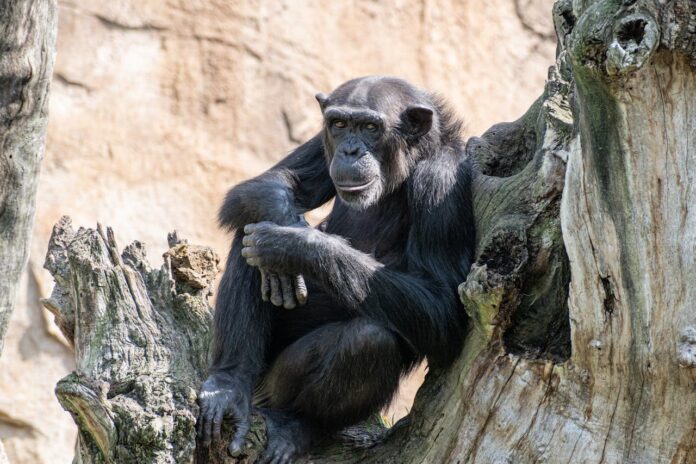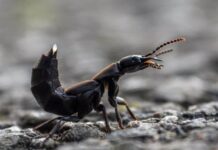Great apes are a group of large, intelligent primates including bonobos, chimpanzees, gorillas, and orangutans. Humans also belong in the group but I just want to focus the ones in the wild instead. Great apes are larger than other primates, and they have high intelligence and impressive cognitive abilities. These intelligent primates have a wide distribution across Africa and Asia, inhabiting tropical and subtropical rainforests and woodlands. Let’s learn about every single one of them below, shall we?
1Bonobo
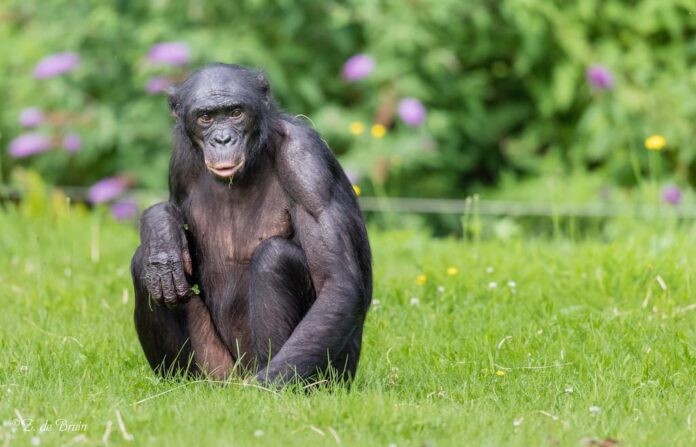
Scientific Name: Pan Paniscus
When it comes to great apes, bonobos are not really the first thought that people think of. Little do we know that they are one of the rarest and most intelligent animals in the world. You can easily tell from their appearance that they are very close relatives of humans. Male bonobos have an average height of 1.19 meters tall when standing upright, while females are only around 1.11 meters. A bonobo has a slim upper body, narrow shoulders, a thin neck, and long limbs; and some of them do have quite muscly arms. It has a black face with pink lips, long hair on its head, small ears, and wide nostrils. The most interesting part is that, just like humans, they have individuated facial features.
Bonobos are both arboreal and terrestrial, but they do not have a defined territory like other ape species. The troop has high-ranking males and females, but it is led by an old and experienced matriarch. She is the decision maker and leader of the non-violent group. Female bonobos earn their rank through experiences and ability to forge alliances with other females. A community of the bonobos range from 30 to 80 individuals, but they separate and reunite on a daily basis. During the day, they break off into small groups to gather food and rejoin together at night.
This great ape is found only in the Democratic Republic of Congo, ranging from the Congo River to the Kasai River. They are omnivorous frugivores, feeding on both fruits and meat as well as eggs, flowers, honey, leaves, seeds, and more. The combination of a limited range and major threats brings their population to an endangered status on the IUCN Red List. Their numbers are currently threatened by habitat loss and hunting for bushmeat, and there are fewer than 50,000 individuals now.
2Chimpanzee
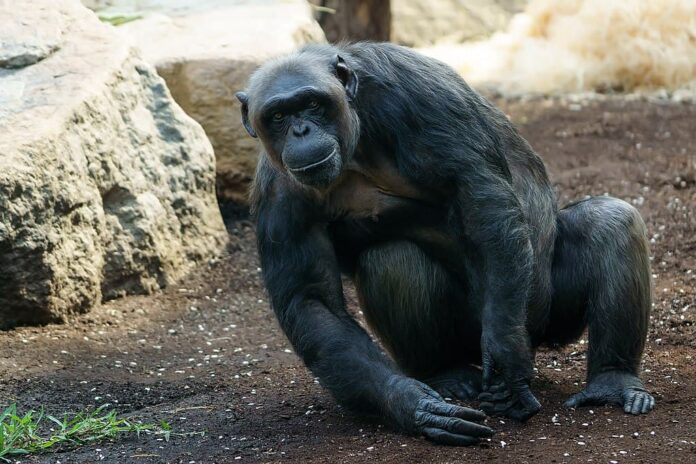
Scientific Name: Pan Troglodytes
Chimpanzees are also one of the closest living relatives of humans, sharing about 98% of our genes. A chimpanzee has a slender body that is covered in coarse black hair, and it has a bare face, fingers, palms, toes, and soles. More than that, a chimp loses its hair as it ages and develops bald spots just like humans. And as they get older, gray or white hair patches begin to appear, usually on the chin and lower area. Both sexes have a similar average height of 1.5 meters tall. Not different from all great apes out there, their arms are also longer than their legs.
Chimp is a great ape species native to the forests and savannas of tropical Africa, living both arboreal and terrestrial life. Their common habitats are deciduous forests, dry woodland savanna mosaic, evergreen rainforests, grassland, montane forests, open woodlands, and primary forests. As omnivorous frugivores, fruits are at the top of the menu, but they also eat bark, leaves, seeds, and stems. Along with that, chimps also feed on birds and their eggs, honey, insects, mammals, and other primates like red-tailed monkeys. What’s fascinating about them is the large number in their groups, ranging from 15 to 150 individuals. Each group has a strict male-dominated hierarchy structure where male leaders settle disputes without violence.
These great apes are also facing the threats that bring their status down to endangered; all 4 species of them. Disease (Ebola), habitat loss from deforestation and logging, and poaching for bushmeat have been making their numbers decrease every year.
3Gorilla

Scientific Name: Gorilla
Here you are looking at the largest great apes among the 4, and the strongest great ape. This primate stands between 1.25 to 1.8 meters, with arm spans of up to 2.6 meters. Males’ height range is from 1.4 to 1.8 meters, while the females’ height range is only 1.25 to 1.5 meters. Gorillas can stand upright, but they prefer to walk using their hands, known as knuckle walking. Gorillas live in troops led by a strong male called silverback, with a harem of multiple adult females and their offspring. A silverback has silver hair on his back all the way to its hip that appears when he reaches maturity. The silverback makes all the decisions, determines the group’s movements, leads the members to feeding sites, and mediates conflicts. But most importantly, he ensures the safety and well-being of everyone in the troop.
Gorillas live in the tropical forests of equatorial Africa, where they inhabit montane forests, submontane forests, swamplands, and more. Their diet consists of a wide range of items, including fruits, leaves, shoots, and stems, as well as ants and termites. One interesting thing is that gorillas rarely drink water because they consume succulent vegetation and morning dew. So even if they don’t live close to a water source, it is still not a problem for them. A gorilla troop does not stay in the same place for more than a day, and they never use the same nest twice. So each morning, the silverback leads his troop to a new area where food is plentiful.
There are two main species: Eastern Gorilla and Western Gorilla, along with a few subspecies. Both species inhabit subtropical or tropical forests in Sub-Saharan Africa. Despite the fact that they are not violent and that they have no natural enemies or predators, their population is not doing well. Unfortunately, both species are classified as Critically Endangered on the IUCN Red List due to a number of threats. Some of the main ones are diseases such as Ebola, habitat destruction, and poaching for the bushmeat trade.
4Orangutan
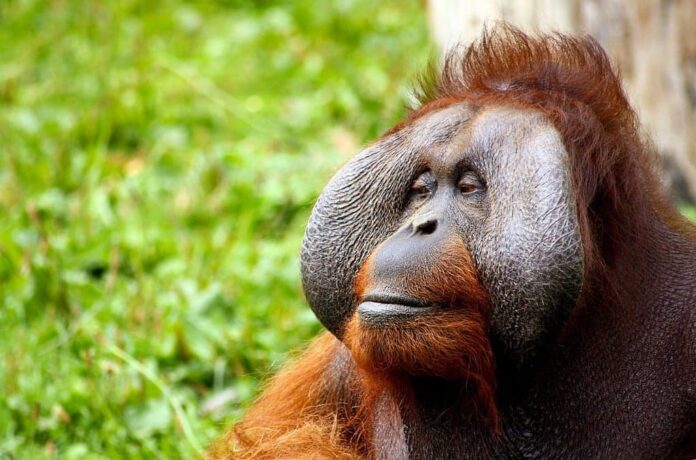
Scientific Name: Pongo
Orangutans are large great apes, with males standing 1.37 meters tall and females are 1.15 meters. An orangutan has proportionally long arms that are around 2 meters, so when it stands, its hands nearly touch the ground. When climbing, an orangutan uses both hands and feet to onto branches as they move horizontally through the rainforest canopy. It has bright orange to reddish-brown hair covering its body, and some males can develop facial hair that resembles a beard. Mature males have large cheek pads known as flanges, which demonstrate genetic fitness and amplify their long calls.
As for this great ape species, they are native to Indonesia and Malaysia, inhabiting rainforests, especially near the rivers. Orangutans are primarily fruit eaters, and they spend most of their time feeding on berries, drupes, and figs. When fruits are less available, they feed on leaves as well as bark, bird eggs, honey, and insects. Being one of the most intelligent primates, orangutans also use a variety of sophisticated tools in their daily lives. They develop their own tools for feeding, like insect-extraction sticks and seed-extraction, and tools for building nests. They are the most arboreal among the great apes as they spend most of their time in trees. Along with that, they are also the most solitary of the great apes as well. Most social bonds are between adult females and their dependent offspring, and adult males are loners.
There are 3 orangutan species, and all of them are considered critically endangered; due to the same threats. Human activities such as deforestation and poaching have caused habitat destruction and severe population declines.
Related Post: Orangutan Species

